Sightings report for March 15th-April 10th
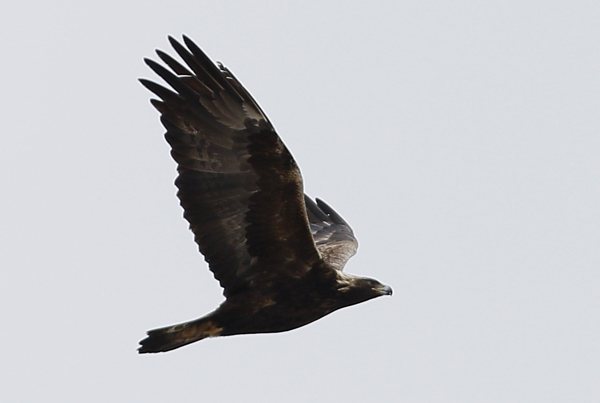
Golden Eagle by Ted Keyel
Greetings! Thank you for your patience as we prepared this new website, but now that we are up and running, let the bird sightings pour forth!
It’s been quite the ride weather-wise this season, two days before the start of the count temperatures in Marquette hit a delightful 61 degrees. This allowed for the first wave of early season migrants to return to the area and even though winds were not always favorable for migration, a steady pulse of birds made for a far birdier March then what is typical for the beginning of a WPBO season. Then April hit… Our showers were snow and ice and winds have remained a pretty constant northerly of the lake, effectively shutting migration down for what is now exceeding two weeks. There is hope however as mid-week there will be a massive warm-up and days of south winds that will bring with them a flood of migrants in time for the start of the Waterbird Count on April 15th.
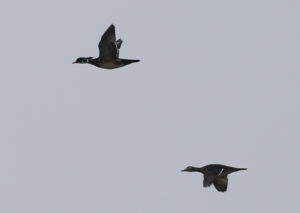
Wood Ducks by Ted Keyel
Waterbirds have understandably been slow, but there has been little pushes of Common Mergansers by the point, with 25 on the 27th, along with the season’s first Killdeer and Ring-billed Gulls. A few Canada Geese and Mallards have been seen and on the 30th, a trio of Wood Ducks flew over the Hawk Deck. Sandhill Cranes made their first appearance on the 19th, with a peak of 7 on the 30th. Great Black-backed Gulls has been seen a few times, though the gull flocks at the harbor have been rather unimpressive so far. A few American Woodcocks have been recorded, mostly by the owl banders at dusk, and have amazingly persisted despite the repeated snowstorms of the last 12 days. Finally the best waterbird so far was seen the day before the season formally started with an early (or more likely over-wintering) Red-necked Grebe in the harbor.
Grouse have been few, but all three species have been recorded with a few Sharp-tailed Grouse and Ruffed Grouse sighted and on March 11th, Susan Kielb photographed a Spruce Grouse along the Cemetery Road on the south side of the Point.
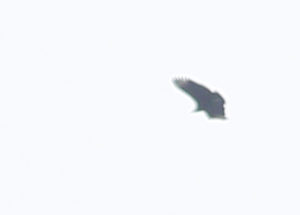
Black Vulture by Ted Keyel
Raptor migration has been surprisingly good for March, with an amazing 14 species recorded by the 1st of April! Normally the hawk count records half that amount of species for the same period. Helping those totals out have been two excellent rarities; a GYRFALCON on the 21st, and a BLACK VULTURE on April 1st! Golden Eagles made an excellent early push with just over 60 recorded, with a peak of 23 on the 18th. 170 Bald Eagles have been tallied in while buteos haven’t made big pushes into the area, 64 Red-tailed Hawks were counted on the 29th. From there, ranging from a few to several individuals of the following species have been- Turkey Vultures, Northern Harriers, all three accipiters (with Northern Goshawk being the most regularly sighted), Red-shouldered & Rough-legged Hawks and both American Kestrels and Merlin all have been recorded. For further details on the hawk count, visit the migration counts blog.
As with the hawk count, please visit the owl blog for a more detailed summary on the season, but the season has been moderately decent thus far. Northern Saw-whet Owls have been the most frequently captured with 100 birds by April 4th, and making a strong early push has been 33 Long-eared Owls. Rounding out the owls reports is the lone Snowy Owl sighting of a bird sitting on the tip on the 29th.
Woodpeckers have been sparse, primarily a handful of Downy Woodpeckers and a female Pileated that kept us company for two weeks on the hawk count, but a Black-backed Woodpecker made a brief appearance on the 25th. In addition to the expected flights of Flickers & Sapsuckers in our near future, I suspect after what has been a very quiet winter in the UP woodpecker-wise, that flights of Downy, Hairy and Pileated Woodpeckers will be noticeable at Whitefish in the coming weeks.
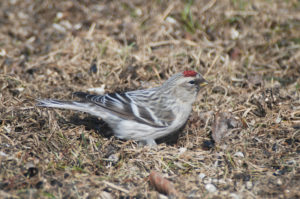
Hoary Redpoll by Skye Haas
The bulk of early season passerines of course have been primarily comprised of boreal finches and more on them in a moment, but our first (and only!) warbler so far was a Yellow-rumped Warbler on the 30th. Blackbirds have made a few modest pushes, with Common Grackle the most numerous and first sighted on the 17th, Red-winged Blackbird first arrival on the 19th and a Rusty Blackbird and 2 Brown-headed Cowbirds on the 30th. An Eastern Meadowlark was seen on April 1st. At the start of the count a couple of American Tree Sparrows were around, but the 30th saw a push of that species that brought with them Song Sparrows, Fox Sparrows and Dark-eyed Juncos including an Oregon Junco. A bit on the early side has been a Brown Thrasher. Bohemian Waxwings have been sighted in small flocks on a semi-regular basis with 176 tallied in so far this season. A few Cedar Waxwings, likely overwintering birds rather than migrants have also been seen. American Robins have made a few pushes with a high count of 45 on the 30th, and small numbers of Snow Buntings have also been present. But it is Common Redpolls that have been our most common songbird present with good numbers seen nearly every day. Over 4,000 have been tallied so far with a peak flight of 559 on the 30th. Bringing with them has been fantastic numbers of Hoary Redpolls with day counts of 5-7 occurring on multiple dates! Pine Siskin numbers have been good and are expected to build, and the start of the season recorded a decent Red Crossbill push with 200 birds so far this season. Pine Grosbeak has been near absent with only 15 observed so far; most of these colorful birds likely migrated out of the UP in the warm weather of early March. Purple Finches made their first appearance on 26th, and American Goldfinch has yet to be seen.
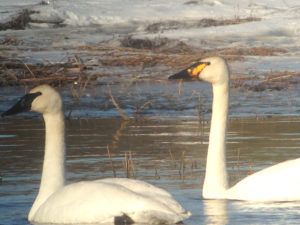
Whooper x Trumpeter Swan hybrid with a Trumpeter Swan by Skye Haas
Sightings of note near Whitefish Point have included semi-regular sightings of Spruce Grouse and Red Crossbill along Vermilion Road, and the mouth of the Tahquamenon River has been host to several waterbird species like American Wigeon, Ring-necked Duck, Bufflehead, Double-crested Cormorant and most notable of all a Trumpeter x Whooper Swan hybrid keeping company with a pair of Trumpeter Swans. This rare hybrid looks superficially like a Tundra Swan with yellow on the base of the bill, but the size of the bird and structure of the head and bill all are consistent with a hybrid Trumpeter-Whooper Swan. This hybrid has only thought to occur in captivity, but this individual was neither banded nor with a clipped hallux. Perhaps still an escapee or possibly the product of an escaped Whooper Swan that mated with a Trumpeter. Either way, a very interesting looking bird! Further afield, mid-March saw fantastic numbers of Snowy Owls in the Rudyard area in eastern Chippewa County. An evening run by WPBO staff on the 14th tallied in an amazing 53 Snowy Owls!
Thanks for reading all of this, more to come over the next week.
Skye Haas
WPBO Field Ornithologist


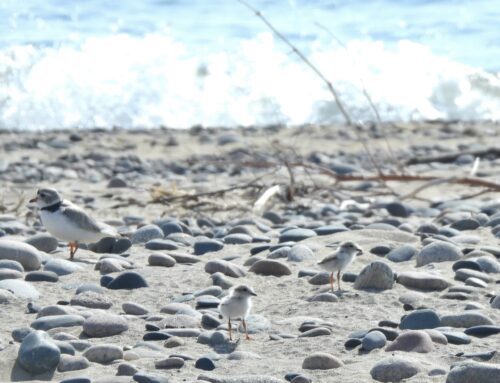
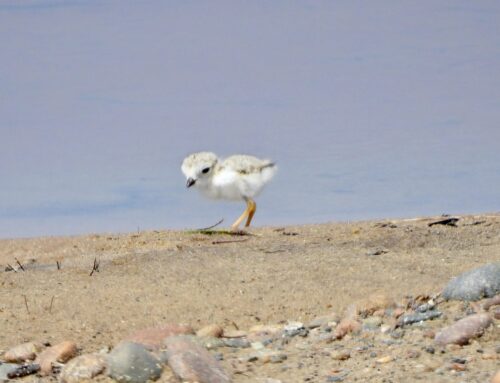
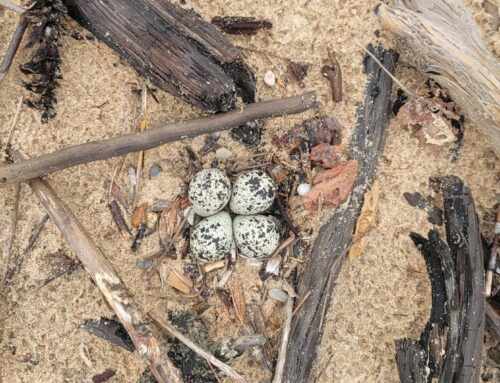
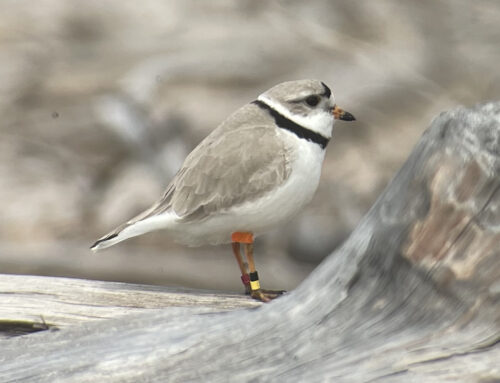
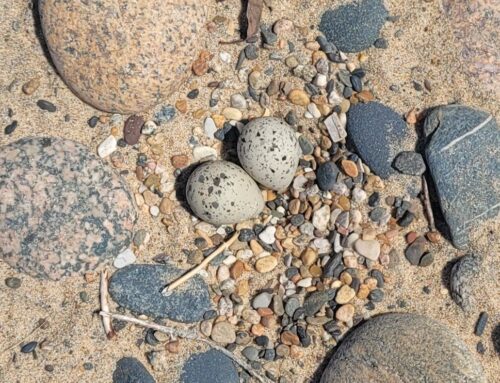
Hi Skye,
You are aptly named for a watcher of migrating birds! Thanks for this newsy post on the start of the migration season. My son Sean (17) and I are driving up to WPBO for our first ever visit today! We hope to see some owl banding when we arrive after dark tonight, and then will return for as much waterbird watching and raptor counting as we can manage tomorrow.
We are both amateur birders who got our start when I coached Ornithology for Science Olympiad when Sean was in middle school. He and I have continued to learn and to go on trips when we can. We’ve done the Christmas bird count in Ann Arbor a couple of times. We are eager to watch and learn from the pros. I hope we will get to meet you and learn from you on our first visit this weekend.
If there is a particular best time of day or “cool event” we should not miss taking place at WPBO tomorrow, please email me or text me where we should be and when. Many thanks,
Sincerely,
Amy Higgins
arhiggins@comcast.net, 734-646-8365